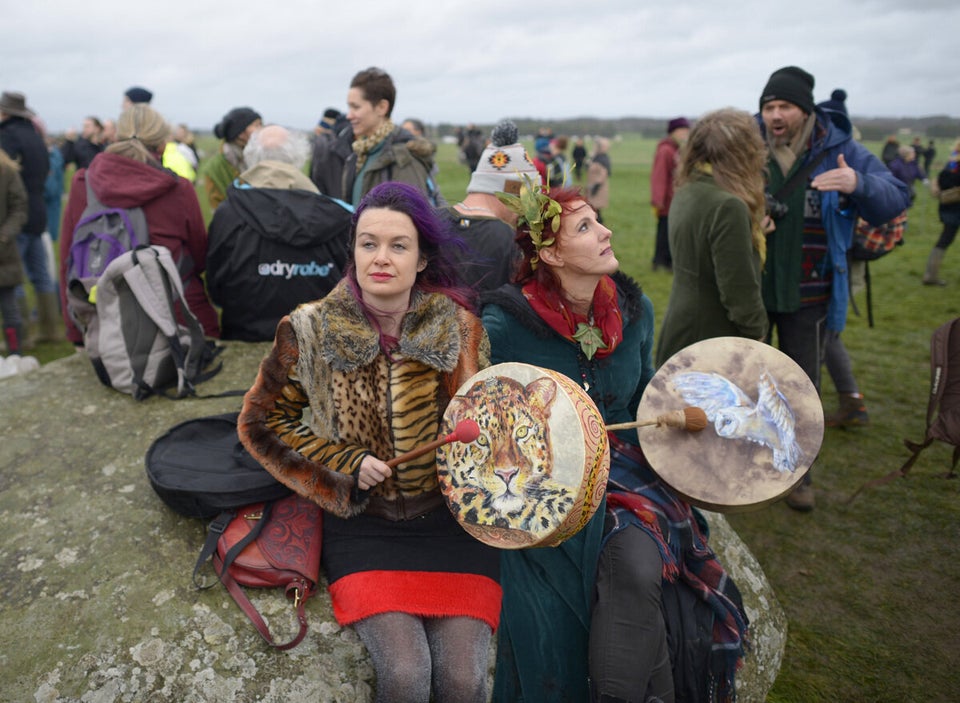Thousands of people including pagans and druids have gathered at Stonehenge to celebrate the winter solstice, the shortest day of the year.
The sun rose over the historical ruins near Salisbury at 8.04am, but the exact moment of this year's solstice took place at 4.49am.
Despite the occasion marking the official beginning of winter, the event may have taken place on the mildest December 22 since records began.
The temperature was due to be only around four degrees colder than during the summer solstice, when the mercury hit 17C. Salisbury was due to hit 15C today, last year it was a much more winter-like 8C.
The Met Office said it was "finely balanced", but sunshine in the afternoon could put the heat on Hoylake's 105-year record for the warmest December 22. The Greater London area is the most likely to beat the record of 16.1C set at Hoylake, Merseyside, in 1910.
The mild weather meant revellers were dressed as warmly as they were at the Stonehenge event in June.
A Met Office spokesman said: "Generally speaking there's been quite a bit of cloud, but if the sun peeps through the clouds in early afternoon, it could just push the temperature up to 16C or something like that."
People dressed in medieval clothing were at the spot to celebrate the solstice, which marks the latest dawn and the point when the sun is at its lowest point in the sky.
A crowd of almost 5,000 people were at the prehistoric Wiltshire landmark for the "very special" time of the latest dawn and the point when the sun is at its lowest in the sky, according to senior Druid, King Arthur Pendragon.
He said: "I think we got about 5,000 people in the summer and we were nearly that and it is winter. It has been a very mild December but throughout the night it was rainy and windy which, in turn, might have put some people off.
"I think a lot of people are looking to nature because of global warming and the environment. They are turning to Earth-bound religions.The winter is a time of renewal and hope.
"I have been going (to Stonehenge) for 30-odd years. It is always very special."
The winter solstice is the annual event which marks the point where the North Pole is tilted 23.5 degrees away from the sun. As a result of the north of Earth leaning away from the Sun, Tuesday will see the fewest hours of sunlight in one day.
Even Google celebrated the solstice, marking the event with one of its trademark doodles, although there was little sign of the wintery scene played out on the search engine's homepage.

Even Google got into the act to mark the winter solstice with a doodle
A spokesman for Historic England said people travel to Stonehenge on the winter solstice because of the monument's alignment with the sun on the winter solstice, and added that it is believed the solstice was of huge importance to Stonehenge's prehistoric users.
The sun sets between the trilithon at the site, which is where two vertical pillars stand next to each other, supporting a horizontal stone on top.
"One of the most important and well-known features of Stonehenge is its alignment on the midwinter sunset-midsummer sunrise solstitial axis," the spokesman said.
"The midwinter sun sets between the two upright stones of the great trilithon. We do not know which solstice was more important to the users of Stonehenge, but several pieces of evidence suggest that midwinter was very important.
"Analysis of pig bones at nearby Durrington Walls suggests that feasting was happening here particularly at midwinter."
The scenes building up to the solstice were filled with excitement:
Time Management Tips To Make The Most Of The Winter Solstice
Depending on where you live, the winter solstice means you’ll have as little as eight hours of sunlight to get all of your work done for the day. And as you've already noticed for the last month or so, earlier sunsets equal sleepier people.
Here are some tips to help you become more productive and make the most of those precious eight hours of daylight we have this time of year — they’re ticking away. Of course, these tips can help any other day of the year too.
Make a To-Do List and don't let it leave your sight.
Lay out tasks for the day on a sticky note and put it up in your workspace. This will let you organize what you’d like to get done for the day and see it all laid out side-by-side to think about how they relate. Physically checking items off will feel concrete. Emails sent, check. Turkey bought, check.
Get started once you sit down.
Taking a second to check irrelevant emails, scroll through social media or read something on Twitter can easily turn into 30 minutes. And the day is already drifting away.
Switch gears every hour.
If your to-do list is daunting and long-term, shift gears every hour to ensure you spend some time working on each little project. Setting a short work period will help you focus and utilize each minute before you have to start in on another project. Separating assignments will make you more productive than switching between different tasks at the same time. A Stanford University study showed that multitasking actually does more harm to your brain and end results than managing one thing at a time — especially when it means juggling electronic devices.
Set time to clear your mind.
Just because you’re pressed for time, doesn’t mean you should skip breaks to calm your thoughts. Studies show that short breaks are healthy and can help you get more done. Meditate for five minutes, get up and stretch, write out what’s on your mind — it can be just what you need if you’re starting to get overloaded and overwhelmed.
Don’t forget that time management also includes your personal life.
It’s easy to put all of your energy into your work and leave yourself with no energy to spend time with friends, your significant other or your family. While you’re scheduling and visualising what needs to be done today, don’t forget to add in baking Christmas cookies with the kids.
Final Thought
Pagan author T. Thorn Coyle wrote in a 2012 HuffPost article that for many contemporary celebrants, solstices "are a chance to still ourselves inside, to behold the glory of the cosmos, and to take a breath with the Sacred."
In the Northern hemisphere, friends gather to celebrate the longest night. We may light candles, or dance around bonfires. We may share festive meals, or sing, or pray. Some of us tell stories and keep vigil as a way of making certain that the sun will rise again. Something in us needs to know that at the end of the longest night, there will be light.
In connecting with the natural world in a way that honors the sacred immanent in all things, we establish a resonance with the seasons. Ritual helps to shift our consciousness to reflect the outer world inside our inner landscape: the sun stands still within us, and time changes. After the longest night, we sing up the dawn. There is a rejoicing that, even in the darkest time, the sun is not vanquished. Sol Invictus -- the Unconquered Sun -- is seen once again, staining the horizon with the promise of hope and brilliance.
